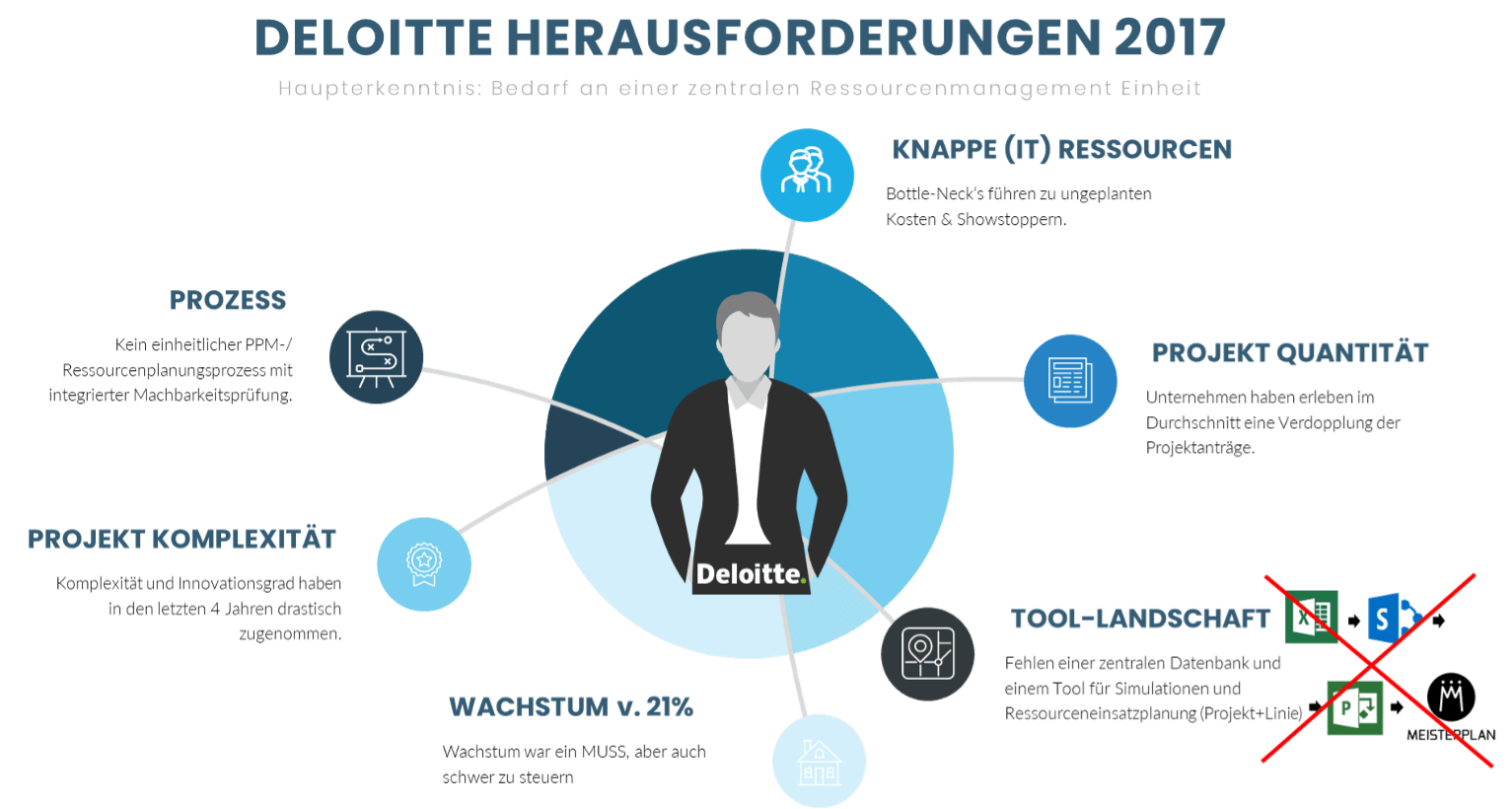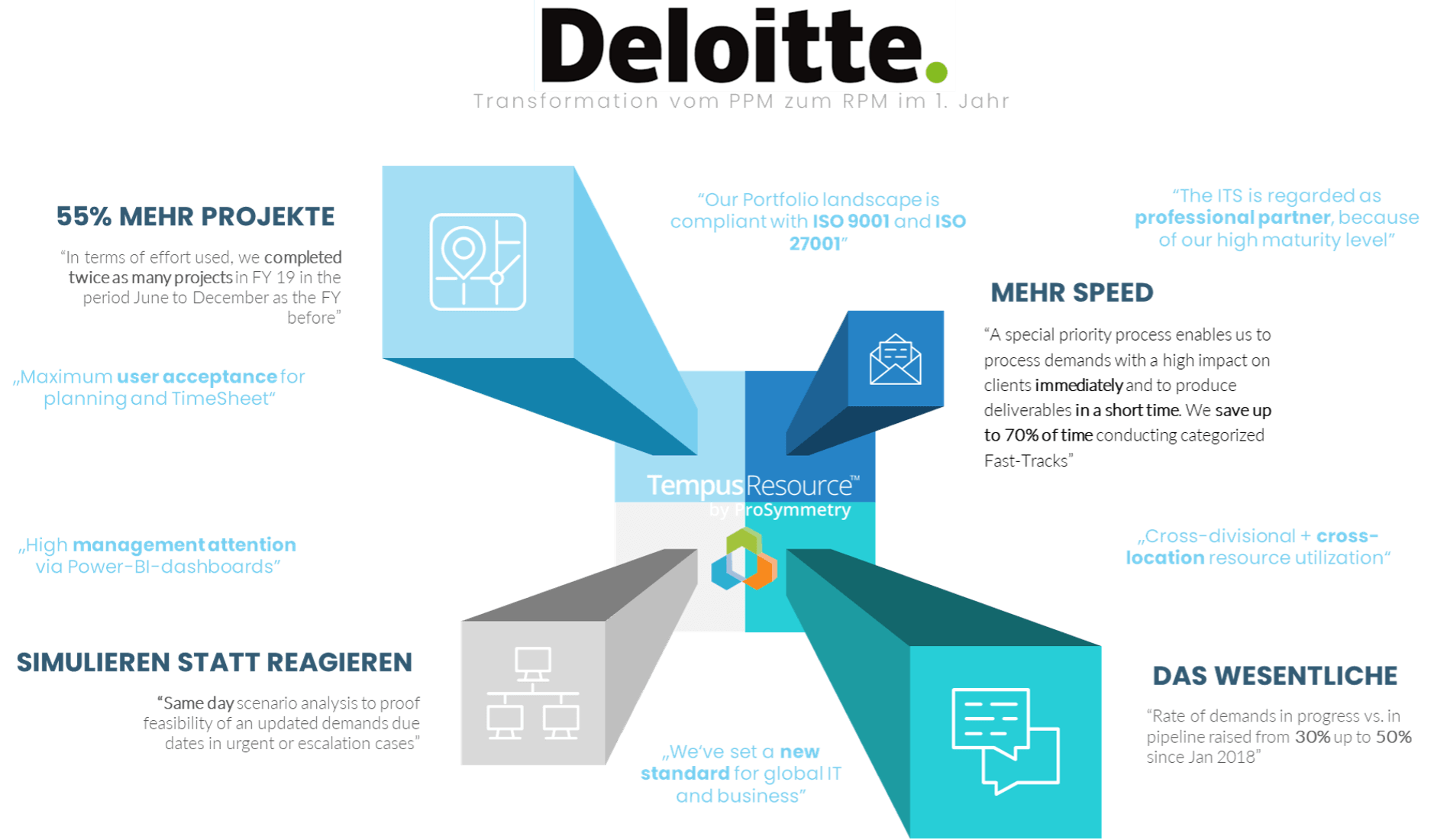Deloitte’s roadmap to Resource Portfolio Management (RPM)
A Valkeen Project Case Study | Management Summary | Initial situation | Approach and solution design | Measurable benefit | Business case
Management summary
The years 2018 and 2019 were exceptionally successful for Deloitte. The company was able to maintain its industry leadership in absolute and relative terms, staying ahead of PWC , EY and KPMG. However, there was another side to this growth: Despite an annual increase in employees of 21%, Deloitte was only to a limited extent able to cope with the disproportionate increase in new initiatives.
Elmar Lotz, Deloitte’s IT portfolio manager, outlines the challenges and problems that arose from bottlenecks and unplanned project delays and offers insights into how these were addressed through a complete process transformation in PPM and a tool-side realignment – a process that was accompanied by Valkeen via a complete implementation in 4 steps. In the first year after implementing our solution, Deloitte’s IT department was able to record the following quantitative benefits:
- Implement 55% more projects
- Save 70% time on high-priority fast tracks
- Set a global standard for resource and portfolio management
- Anticipate bottlenecks and proactively manage bottlenecks
- Assign employees cross-functionally and across locations
Where we started
Challenges in resource management and PPM have increased steadily since 2015, and initiated the start of Deloitte’s optimization process in 2017. In that year, the company’s interactions could be described in a simplified form using the following 3 processes:
The challenges mentioned above also had strong negative interdependencies, and the increasing volume of project inquiries and their growing complexity meant the recruitment of new employees. The increased complexity of the activities made it more difficult to identify bottlenecks in order to reduce them accordingly, and the process complexity and lack of user acceptance of the implemented tools compounded the problem. Projects were often managed by simply bypassing the necessary processes, which meant that resource deployment plans and capacities for portfolio management were not particularly resilient.
Approach and solution design
It was clear that these challenges could no longer be met by the recruitment of additional staff, and that the company would have to optimize the use of its existing resources. Our goal at Deloitte’s: To use available resources, skills and capacities more efficiently and in accordance with the strategy.
Our approach to resource management implementations includes procedural, methodical and technical (tool) components. And that’s exactly the order in which we rolled out the roadmap for Deloitte: The process specified the solution design, the methodology and the tools used.
Deloitte and Valkeen were able to establish a profound resource portfolio management (RPM) process over a time horizon of approximately 15 months – from the initial meeting, through the technical conception to the go-live and an initial, quantitative measurement of benefits. Our 4-step roadmap to Resource Portfolio Management (RPM) was made up of the following factors:
“The solution to bottlenecks is usually not (only) in hiring additional staff, but in optimizing the use of resources.“
(Marc Neckermann, CEO, Valkeen)
Step 1: Stakeholder analysis
Firstly, representative employees were identified in the areas of team and department heads, project managers, PMO and PPM. Using our fast-track interview process, the stakeholders were asked about PPM and resource management. This first step is one that we recommend to all companies before starting the conception phase, because the results of this analysis will be used as the starting point for change management in the project and at the same time as the anchor for continuous improvement and buy-in. Because we, as an external consulting firm, conducted the interviews anonymously, we were able to create a communication platform on which everyone was free to express themselves with us, and even the core team members heard many things for the first time.
Step 2: Solution design (process, methodology and tool)
Based on the results of the stakeholder analysis and proven best practices, Valkeen developed a draft process that sets clear responsibilities, addresses the wishes of the stakeholders and, above all, is “lean” and understood by everyone.
The success factors of our process were
(A) the 2-stage approval process: initiatives were only planned in detail if they had previously been feasibility checked using simulation and scenario analysis. The prioritization is also based on best-practice factors. Only projects relating directly to the approved portfolio scenario are allowed to go forward into the second phase of planning, with the aim of significantly reducing the overheads of the detailed planning of initiatives that are either not useful, not important, not urgent, or simply not feasible.
(B) a resource request and approval process that was fully integrated into the PPM process to plan along with team leaders based on a single-source-of-truth.
(C) the integration of Fast-Tracking for high-priority initiatives that would create quick customer benefits, so that there would be no need to steer them past the existing process.
Source: Deloitte
Step 3: PoC solution design with Tempus Resource
One of the main requirements for the evaluation of a possible system was that only those systems that had been purpose-built for resource management should be considered, rather than PPM tools that also covered resource management. The reason behind this was that Deloitte was aiming for a high level of maturity in resource management and had already had too many negative experiences with previous tools. The main criteria were:
After an initial product demo, Tempus Resource was selected as the tool for a PoC. The PoC (using real data) only took 3 weeks in total, since Tempus 1. has a drag-and-drop Excel import connector and 2. offers a standard connector to MS Project Server. The resource, project and allocation data were migrated into Tempus after a 30-minute call so that they could be directly used for testing. All of the must and can criteria were met, and the PoC was able to offer a good idea of what further implementation phases and the potential for expansion (such as project management, financial planning, skill management) would look like.
Step 4: Iterative implementation
After the PoC had been successfully completed, the implementation process involved replacing the Microsoft Project Server for project resource planning, an in-house development for timesheets and Meisterplan for portfolio and capacity simulation with Tempus Resource and beginning iteratively with the first phase of implementation. Strict attention was paid to finding a good mix between what would be reasonable for the organization and what would actually create benefits rather than creating new work. The results of the stakeholder analysis carried out at the beginning of the project could therefore be continuously checked for fulfillment.
I. Benefit “Throughput and Time-to-market”
After just over a year, an initial quantitative benefit measurement was drawn up, and the result was considered to be very satisfactory for all participants.
Reports and evaluations of the throughput times and throughput amounts before and after implementation provided data for measurement.
It should be emphasized that 55% more projects were implemented because the available capacities were used in a more targeted and efficient manner, and at the same time unwanted project delays and bottlenecks have become less very likely to arise. The potential of the hoped-for cross-functional and cross-site deployment of employees throughout Germany was also realized.
The throughput time of high-priority projects with direct customer benefit was tracked, and a 70% time saving was foudn.
Central IT, which in the past had more of a reputation as a cost center, is now perceived as a “professional partner” of the business units at Deloitte and now accounts for a large proportion of the company’s added value.
Valkeen Consulting | Infographs
II. Benefit “Portfolio Handling and Tempus Resource”
Tempus Resource now enables Deloitte to perform complex simulation and scenario analysis and directly answer critical questions within minutes, such as:
- What if a project is postponed?
- What if a resource drops out?
- What if we try to start this project next week?
The most important thing here is that the data is consistently reliable because the planning and forecast data is entered using an intuitive interface and that the employees themselves benefit from it. Meanwhile, Tempus Resource, as a tool specially developed for resource management, takes over almost all the methodologies by itself, supporting uniform capacity management, dynamically adapting role concepts and easily managing a shared resource pool.
The benefits speak for themselves: The solution design of the IT in combination with Tempus Resource on the tool side is now being rolled out in many other business areas in Germany and is seen worldwide as a potential “standard solution” for resource and portfolio management at Deloitte.
Your Resource Portfolio Management business case
Contact us if you want to assess the quantified potential of your resource management implementation and use it as a communication tool. Use our business case, in which you can enter selected parameters to directly simulate your own company’s potential.






